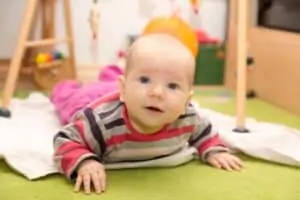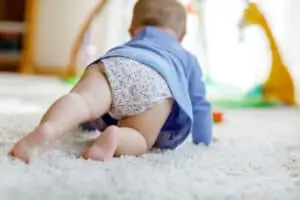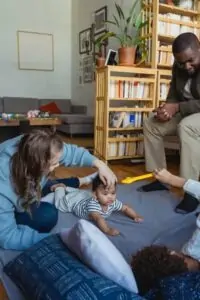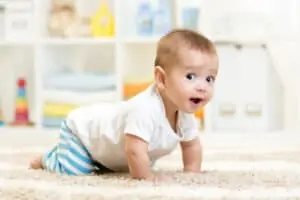When I first became a mom, despite everything I read, there were some things I just had no idea about until I saw them with my own eyes.
I suppose I could have read about it, but it may have evaporated from my brain and now floating somewhere in outer space.
Anyway, baby crawling style was likely in that stuff I read. I knew crawling on hands and knees was considered the standard norm. So that’s why I couldn’t help but notice a pair of boy twins in the playgroup we joined when my eldest was little, and we lived in China.
I saw the baby crawling with one leg tucked in. The other baby was scooting backward on his back. While a baby crawling backward is pretty normal in how they learn to do it right, I knew crawling with one leg was a bit off.
What’s going on with the crawling with one leg? It’s asymmetrical crawling which I’ll get to in a second. Read on, and I’ll explain what it means when a baby drags a leg when crawling and when a baby crawls with one leg up, among other things!
Is asymmetrical crawling normal?
I often hate saying “normal” because it’s a subjective term. What I think is normal may be weird for you. However, when I talk about “normal” here, I’m going with what the AAP defines in these cases.
You may wonder if asymmetrical crawling is bad. What it usually indicates is that there is low muscle tone, coordination issues, or even developmental delays. The thing here is not to freak out and cry that something is wrong.
If you think your child isn’t crawling properly, the best course of action is to take a video of the movement and show your pediatrician to get a proper diagnosis.
Most doctors aren’t concerned if they see a child crawling asymmetrically as long as the strength and muscle tone develop on both sides of the body. If the asymmetry is noted when your child goes from sitting to onto their bellies or not engaging both sides of the body equally with holding things in their hands, this is more of an area to be concerned with.
Why does my baby crawl with one leg?
Or perhaps your baby crawls in circles or does something else you wonder about. Is it normal? Oh man, if I had a dollar for every time, I wondered if I could buy my own private island complete with round-the-clock service.
With asymmetrical crawling, the reason may be due to your baby’s muscles, hips, or their own body awareness. They may use one side of the body over the other, affecting more than strength. It can also cause trouble with coordination and vision.
As such, you may notice a few things…
- Asymmetrical crawling
This is when you see your child moving their right hand with their right foot and ditto for the left side. The pelvis and spine are leaning to the side, making muscle imbalances. Spine curving can lead to scoliosis, impacting how they walk, run, and move through life. If you notice this, have your doctor check things out to correct the issue.
- Bunny hop
While it sounds cute, you don’t want to see your child doing the bunny hop. They move both legs together and keep the knees close to the chest in a sort of hop movement. This usually indicates your child has trouble going from sitting to being on all fours. When this happens, your child can overuse their hip flexor and weaken the hip extensor.
- Frog leg
If your child has knees that are wider than the hips and their back over-curves, it can lead to weak abdominal muscles and hips. This is something you can work together with your pediatrician to correct.
- Bottom scooting
Some kids just scoot around on their butts, using their hands to propel them. This isn’t so unusual though you want to discourage it simply because it can cause the muscles and hip joints to develop asymmetrically. It’s easy to help them make this change with a bit of encouragement from you.
- Baby drags leg when crawling
Often, this is no cause for concern when your baby starts to move through the crawling stages. But keep an eye on it; if this continues, you may want your pediatrician to evaluate your child for a neurological exam to ensure all nerves are firing as they should.
In some cases, dragging a leg may indicate an injury. Anything can happen in a flash when you’ve got your back turned. Yes, even in the 2 seconds you ran to use the bathroom. This phase of life for your baby will keep you on your toes constantly.
If your baby seems in pain or agitated and dragging a leg or anything like that, she may have a fracture. It could have happened with a caretaker or at daycare, so when you see something like this, take your child to the doctor to get a proper diagnosis and treatment.
Does asymmetrical crawling mean autism?
No, asymmetrical crawling doesn’t automatically mean your child has autism. Some babies initially pull to one side more than the other. Others may drag that leg or rest one foot down underneath them to propel themselves.
There IS research that shows autistic children do make asymmetrical movements during crawling. But that doesn’t mean your child is autistic.
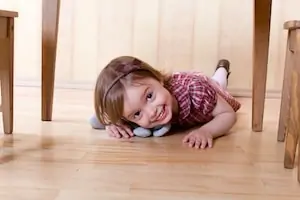
What should you do?
Well, panicking will get you nowhere. Instead, know what to look for with signs of autism. For babies, you’ll likely be screening your child at each doctor’s appointment as per usual. Your pediatrician will note if any of the signs are present.
You can also keep an eye out for your baby. By the age of 2 months, babies can make eye contact. If your baby has autism, they may avoid that eye contact. Without this condition, babies with autism will not point or gesture as much as children.
They also won’t really respond to their name, refrain from showing emotion in facial expressions, and have delayed language or speech.
The bottom line here is this: if your baby is crawling in an asymmetrical way and is just starting to crawl, keep watch. Show them how to crawl, too, and if you see them crawl in any of the typical ways, they are most likely fine.
You should also make a video of any behavior that has you wondering and share it with your pediatrician. They will be able to make a proper diagnosis and help your child.
Is regular crawling important?
Yes, and no, all at once. It is because it helps your child develop strength in muscles that aid in locomotion. Those shoulder, neck, core, and hip muscles play a role in your child’s activity. These also lead up to walking.
However, not every child will crawl first. They may go straight to walking! Some say it’s a good idea to show them how to crawl anyway to help them boost those muscles. I say go with what your doctor advises!
How do I fix my baby’s asymmetrical crawling?
Perhaps the easiest way to fix this crawling style is to check out my article about how to help your baby learn to crawl. I have plenty of tips in there, though I’ll give you the rundown.
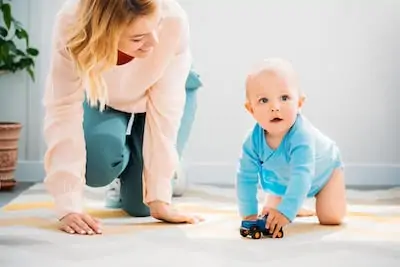
Before I even get that far, though, I want you to know that not every baby crawls in the traditional style. There are many ways a baby can crawl that are all considered normal progression. I also wrote about the different types and stages of crawling, so read up on that.
Even though I covered this before, I have to insist that if you’re not doing tummy time with your tot, you need to do this. Yes, they will cry and carry on a bit. This is normal. You have to be like a cheerful camp counselor encouraging your child every step of the way.
Never EVER leave your baby unattended during tummy time. Not even for a second.
Tummy time should be conducted about 3 times a day and can be very short per session. In my other articles, I linked some helpful baby toys for that. Some things can help grab their attention and get them to crawl over to it or encourage them to lift their heads high.
The AAP also discourages those baby walkers, but I used them for my kids. Granted, they had been walking on their own, so it added incentive for them to get it and push it around once they moved on two feet.
What should I do now?
If your child isn’t crawling, I recommend working on that tummy time ASAP. If they are crawling and it seems asymmetrical, get down on the floor with them. Never lose a cheery demeanor. Kids pick up on this. Instead, coach them along.
Often, it may just be a preference for your child when they move in asymmetrical crawling styles. So if you see it a few times, don’t get bent out of shape but start showing them how to crawl on all fours. If they progress and crawl the right way, there’s nothing wrong.
But if you keep showing them how to crawl and they do one of the asymmetrical styles of unusual crawling I discussed above every time, take that video and make an appointment with the pediatrician. They’ll be able to run tests and help correct any problems.
Well, what if it IS autism?
The good news is that if it is, in fact, autism, you’ll know sooner rather than later. And with this early intervention, you’ll be able to help give your child the best start, no matter the diagnosis.
Honestly, Mama, we’re in this for the long haul. We’ll worry about them as babies. Then they become toddlers, and we worry about that. Then they go to preschool, and we worry about how they’ll do in school. And then it’s off to elementary school. And so on.
Life is all about changing. It never stays the same. You have to roll with the punches. I hope I can help make them easier for you by offering information and advice.
Stay strong and know that there is much love coming your way and that your doctor can help lead the way should they find anything unusual. Hang in there!
Leslie Berry lives with her husband and two young daughters in Los Altos, California, where she loves helping other moms get comfortable with motherhood and embracing the insanity with facts peppered with laughs.
She loves eating too much sushi, exercising, and jamming out on her Fender. Read more about Leslie here.

